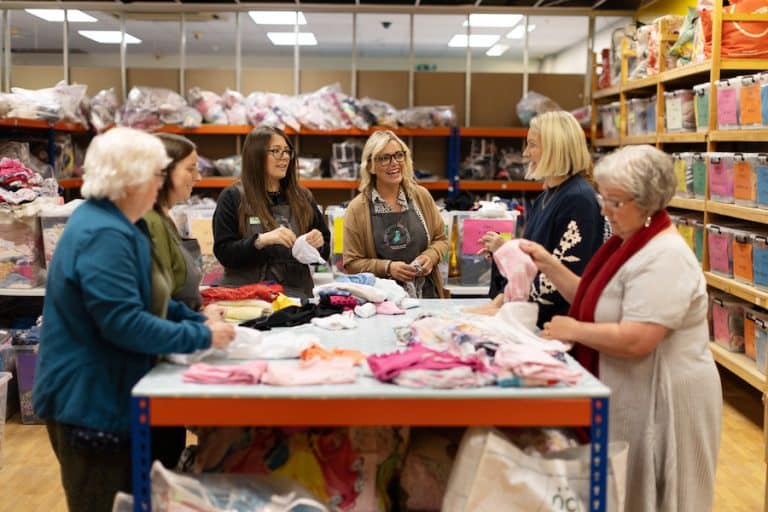The story of Manchester in 101 objects: #12 the rise of the machine age
- Written by Ed Glinert
- Last updated 6 years ago
- Culture, History

Story: The Rise of the Machine Age
Object: Kay’s Flying Shuttle
Year: 1733
Location: Town Hall Mural
In No 8, The Birth of Textiles in Manchester, we learnt that King Edward III introduced Flemish weavers to Manchester in 1363 to boost the local cloth trade. This was instrumental in the rise of Manchester as a great centre of textiles. Yet, astonishingly, for four hundred years there was no discernible improvement in the technology used.
This seems unthinkable today, when technology advances too quickly for most people to keep up with. But this was pre-Industrial Revolution.
Change came in the 18th century with a succession of ingenious inventions that revolutionised industry, not least the cotton industry. After centuries of nothing, Britain saw the following inventions:
1712 Thomas Newcomen devises an atmospheric steam engine
1733 John Kay invents the Flying Shuttle in Bury
1764 James Hargreaves creates the Spinning Jenny which could spin 8 threads at once Soon it was spinning 120 threads simultaneously
1769 James Watt (who has a statue in Piccadilly Gardens) improves the Newcomen steam engine
1769 Richard Arkwright patents the Water Frame, a machine with cogs linked to a wheel turned by running water. Two years later he opens Cromford Mill in Derbyshire. It is the first water-powered cotton spinning mill and employs 200 workers. He builds his Shudehill Mill in 1782
1779 Samuel Crompton devises the Spinning Mule which produces finer, stronger thread
1781 Boulton and Watt make a steam engine that can be used in a cotton mill
1785 Edmund Cartwright invents the power loom.
Kay’s Flying Shuttle was the first new cotton machine and so is particularly important in Manchester terms. Before Kay, textile workers had “thrown” the shuttle with their hands. This meant that at least two weavers were needed at the loom, throwing the shuttle to each other. Now, with this invention, the weavers could get through their work much more quickly by themselves.
During the 18th century, the cotton industry changed from being a home-based (cottage) industry to a large-scale factory-based industry employing thousands of workers in huge mills, some of the earliest of which survive in Ancoats.
But why did this happen in Britain? Why not Finland or Spain or Greece? The clue lies in a man whose statue resides in the reading room of the John Rylands Library: Francis Bacon, the greatest of renaissance men, philosopher, writer and politician.
In 1620, Bacon outlined his method in his book Novum Organum or “New Method”. It propounded the revolutionary idea that to understand how the world works, one should experiment, write down the findings, and conduct a better experiment next time. That simple.
This new scientific principle derided the long-held dominant view that nature could be explained by alchemy, magic, and superstition. But it took around a hundred years for society to catch up with Francis Bacon. When it did, it happened even more so in the cotton industry in Manchester.
Read how Manchester got its name here. For more information on Ed Glinert’s tours of Manchester, click here.
- This article was last updated 6 years ago.
- It was first published on 8 March 2019 and is subject to be updated from time to time. Please refresh or return to see the latest version.
Did we miss something? Let us know: [email protected]
Want to be the first to receive all the latest news stories, what’s on and events from the heart of Manchester? Sign up here.
Manchester is a successful city, but many people suffer. I Love Manchester helps raise awareness and funds to help improve the lives and prospects of people across Greater Manchester – and we can’t do it without your help. So please support us with what you can so we can continue to spread the love. Thank you in advance!
An email you’ll love. Subscribe to our newsletter to get the latest news stories delivered direct to your inbox.
Got a story worth sharing?
What’s the story? We are all ears when it comes to positive news and inspiring stories. You can send story ideas to [email protected]
While we can’t guarantee to publish everything, we will always consider any enquiry or idea that promotes:
- Independent new openings
- Human interest
- Not-for-profit organisations
- Community Interest Companies (CiCs) and projects
- Charities and charitable initiatives
- Affordability and offers saving people over 20%
For anything else, don’t hesitate to get in touch with us about advertorials (from £350+VAT) and advertising opportunities: [email protected]

The very special toy shop where parents don’t pay a penny is open – and busier than ever

Manchester’s oldest homelessness charity celebrates 40 years of supporting the needy

Games, science and history collide at Manchester’s Science and Industry Museum this winter

Best bars and pubs to watch the football and live sport in Manchester

How Baguley Hall Primary School is nourishing minds with a morning Magic Breakfast
















